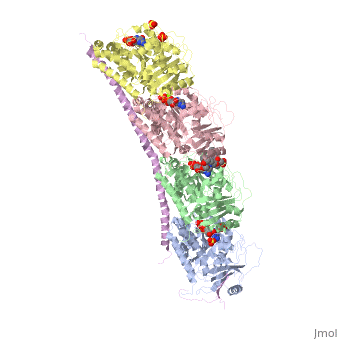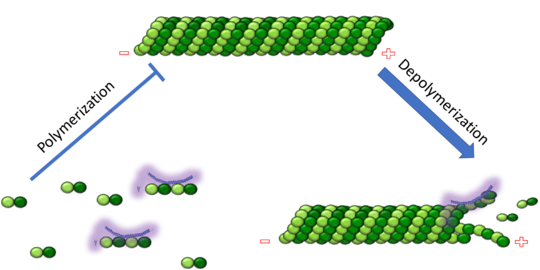User:Alisa Cario
From Proteopedia
(Difference between revisions)
| Line 20: | Line 20: | ||
== '''Introduction and Background''' == | == '''Introduction and Background''' == | ||
| - | The cytoskeleton brings structure to the cell, is integral in cell division, and aids in migration. One of the constitutive parts of the cytoskeleton are microtubules. Microtubules are polymerized from tubulin subunits that incorporate into a hollow cylindrical structure linked together by lateral and vertical hydrogen bonds. Each tubulin subunit is made from a heterodimer of alpha and beta tubulin. Both alpha and beta tubulin are known to bind to GTP. However, only the beta subunit hydrolyzes GTP, which occurs once incorporated into microtubules. The beta tubulin hydrolysis of GTP to GDP is known to destabilize microtubules. Microtubules have polarity where one end of microtubule, called the plus end, has a greater affinity to add tubulin subunits than the other end, called the minus end. Microtubules are inherently dynamic, going through periods of depolymerization, known as catastrophe, and then return to polymerization, known as rescue. Microtubules can also go through a process called | + | The cytoskeleton brings structure to the cell, is integral in cell division, and aids in migration. One of the constitutive parts of the cytoskeleton are microtubules. Microtubules are polymerized from tubulin subunits that incorporate into a hollow cylindrical structure linked together by lateral and vertical hydrogen bonds. Each tubulin subunit is made from a heterodimer of alpha and beta tubulin. Both alpha and beta tubulin are known to bind to GTP. However, only the beta subunit hydrolyzes GTP, which occurs once incorporated into microtubules. The beta tubulin hydrolysis of GTP to GDP is known to destabilize microtubules. Microtubules have polarity where one end of microtubule, called the plus end, has a greater affinity to add tubulin subunits than the other end, called the minus end. Microtubules are inherently dynamic, going through periods of depolymerization, known as catastrophe, and then return to polymerization, known as rescue. Microtubules can also go through a process called treadmilling, where the length of the microtubule does not change but the rate of polymerization at the plus end equals the rate of depolymerization at the minus end. There are a number of microtubule associated proteins (MAPs) that are known to regulate the dynamics of microtubules. Some examples of this include MAPTau, MAP2 and stathmin. See [[tubulin]], [[tau]]. |
| - | [[Image:Stathmin_figure_cario1.png|center|thumb| upright=3| Figure 1. Adapted from Ruben 2004. Stathmin in purple can bind to tubulin dimers to prevent polymerization or to microtubules to increase the rate of catastrophe. ]] | + | [[Image:Stathmin_figure_cario1.png|center|thumb| upright=3| Figure 1. Adapted from ''Ruben 2004''. Stathmin, in purple, can bind to tubulin dimers to prevent polymerization or to microtubules to increase the rate of catastrophe. ]] |
== '''Function''' == | == '''Function''' == | ||
| - | <scene name='77/778894/Stathmin/1'>Stathmin</scene>, also known as oncoprotein 18 or metablastin, is a 19kDa microtubule associated protein known to destabilize microtubules <ref>PMID:8598048</ref>. Stathmin | + | <scene name='77/778894/Stathmin/1'>Stathmin</scene>, also known as oncoprotein 18 or metablastin, is a 19kDa microtubule associated protein known to destabilize microtubules <ref>PMID:8598048</ref>. Stathmin belongs to a larger family of stathmin-like proteins. These proteins are cell cycle and developmentally regulated, known to play a role in proliferation, differentiation, and function of cells <ref>PMID:9312271</ref> <ref>PMID: 9880330</ref>. Stathmin family proteins can bind to <scene name='77/778894/Highlight_of_tubulin/1'>tubulin dimers</scene> to inhibit polymerization or can bind to the microtubule to enhance the rate of catastrophe<ref>PMID:8598048</ref> |
| - | '''Mitosis''': Stathmin's role in the cell cycle progression is | + | '''Mitosis''': Stathmin's role in the cell cycle progression is characterized. During interphase, microtubules are relatively stable. However during the onset of mitosis, stathmin is upregulated to increase the rate of catastrophe of microtubules, causing them to become more dynamic. Stathmin has also been shown to bind and sequester two tubulin heterodimers, reducing the amount of available tubulin to polymerize microtubules <ref>PMID:9312271</ref>. However, as mitosis progresses, microtubules must repolymerize to form the mitotic spindle. Stathmin is regulated during this process by phosphorylation <ref>PMID: 7982983</ref> <ref>PMID: 1737801</ref>. There are four known <scene name='77/778894/Stathmin_phospho/1'>phosphorylation sites of stathmin</scene>, serine 16, serine 25, serine 38, and serine 63 which are known to be a target of cyclin-dependent kinases <ref>PMID: 8376365</ref> <ref>PMID: 9271428</ref>. Stathmin overexpression prevents mitotic spindle formation where inhibition interferes with later stages in mitosis <ref>PMID: 10022911</ref>. |
'''Migration''': The cytoskeleton is a vital part of cell migration. Microtubules are needed to retract from the trailing edge to move the cell forward. Stathmin is thought to have a role in migration, allowing to microtubules to depolymerize to aid in movement. Stathmin has been show to be a part of the integrin alpha5 beta1/FAK/ ERK pathway <ref>PMID: 9462839</ref>. Overexpression of stathmin increases motility of GN-11 neurons <ref>PMID:15625246</ref>. | '''Migration''': The cytoskeleton is a vital part of cell migration. Microtubules are needed to retract from the trailing edge to move the cell forward. Stathmin is thought to have a role in migration, allowing to microtubules to depolymerize to aid in movement. Stathmin has been show to be a part of the integrin alpha5 beta1/FAK/ ERK pathway <ref>PMID: 9462839</ref>. Overexpression of stathmin increases motility of GN-11 neurons <ref>PMID:15625246</ref>. | ||
| - | '''Differentiation''': Stathmin expression | + | '''Differentiation''': Stathmin family proteins expression are regulated during stages of development. It is regulated in early and late embryogenesis <ref>PMID: 1893566</ref>. Stathmin is regulated in differentiating muscle cells, T lymphocytes, and oligodendryocytes <ref>PMID: 22529300</ref> <ref>PMID: 14603467</ref>. Other family members are regulated in stages in development. |
| + | |||
| + | == '''Evolutionary conservation''' == | ||
| + | Stathmin belongs to a gene family that have a characteristic stathmin-like domain spanning across eukaryotes. This family includes Stathmin-1, SCG10/stathmin-2, SCILP/stathmin-3, and RB3/stathmin-4. RB3 is alternatively spliced to form RB3 RB3' and RB3'' <ref>PMID: 9342231</ref>. SCG10 and SCLIP, are exclusively neuronal proteins, while RB3 is expressed mostly in the brain but some in the adrenal glands <ref>PMID: 8344928</ref> <ref>PMID: 2776625</ref>. Unlike the neuronal proteins, stathmin-1 is ubiquitously expressed in all cell types. All members of this family contain the C-terminal coiled coil domain. However, the binding affinity to tubulin of the protein family members differ <ref>PMID: 11278715</ref>. Interestingly, the neuronal isoforms are known to contain an additional N-terminal domain to affect their localization <ref>PMID: 9788875</ref>. | ||
== '''Structure''' == | == '''Structure''' == | ||
| Line 52: | Line 55: | ||
'''Cancer''': Due to stathmin's role in mitosis and cell migration, it is not surprising that is has been implicated in many cancers and is an active target of cancer therapeutics. Stathmin is defined as an oncoprotein. Overexpression of stathmin has been shown to increase metastasis, worse prognosis, and increased chemoresistance <ref>PMID: 20087351</ref> <ref>PMID: 18930345</ref>. Stathmin levels are known to be increasesd in a number of cancers. Stathmin was seen to be upregulated in breast cancer tissue comparative with normal breast tissue <ref>PMID: 10638981</ref>. Another study was done to show stathmin upregulation in esophageal squamous cell carcinomas <ref>PMID: 23229199></ref>. Studies using a non-phosphorylatable stathmin mutant shows that cells arrest during mitosis <ref>PMID: 9788875</ref>. | '''Cancer''': Due to stathmin's role in mitosis and cell migration, it is not surprising that is has been implicated in many cancers and is an active target of cancer therapeutics. Stathmin is defined as an oncoprotein. Overexpression of stathmin has been shown to increase metastasis, worse prognosis, and increased chemoresistance <ref>PMID: 20087351</ref> <ref>PMID: 18930345</ref>. Stathmin levels are known to be increasesd in a number of cancers. Stathmin was seen to be upregulated in breast cancer tissue comparative with normal breast tissue <ref>PMID: 10638981</ref>. Another study was done to show stathmin upregulation in esophageal squamous cell carcinomas <ref>PMID: 23229199></ref>. Studies using a non-phosphorylatable stathmin mutant shows that cells arrest during mitosis <ref>PMID: 9788875</ref>. | ||
| - | |||
| - | |||
| - | == '''Evolutionary conservation''' == | ||
| - | Stathmin belongs to a gene family that have a characteristic stathmin-like domain spanning across eukaryotes. This family includes Stathmin-1, SCG10/stathmin-2, SCILP/stathmin-3, and RB3/stathmin-4. RB3 is alternatively spliced to form RB3 RB3' and RB3'' <ref>PMID: 9342231</ref>. SCG10 and SCLIP, are exclusively neuronal proteins, while RB3 is expressed mostly in the brain but some in the adrenal glands <ref>PMID: 8344928</ref> <ref>PMID: 2776625</ref>. Unlike the neuronal proteins, stathmin-1 is ubiquitously expressed in all cell types. All members of this family contain the C-terminal coiled coil domain. However, the binding affinity to tubulin of the protein family members differ <ref>PMID: 11278715</ref>. Interestingly, the neuronal isoforms are known to contain an additional N-terminal domain to affect their localization <ref>PMID: 9788875</ref>. | ||
== Links to available structures == | == Links to available structures == | ||
Revision as of 12:48, 30 April 2018
* Full Real Name: Alisa Cario
- Position: Graduate Student
- Institution (NO ABBREVIATIONS): University of Vermont
- City, State/Province, Country: Burlington, VT USA
- Field of Expertise or Study: Creation of protopedia page for a class project. The class is Proteins 1 under Dr. Stephen Everse
Stathmin-4 (RB3) bound to Tubulin stabilized with Vinblastine
4eb6
| |||||||||||


